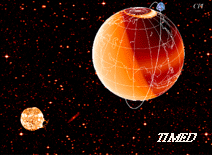
Thermosphere, Ionosphere, Mesosphere
Energetics and Dynamics (TIMED)
Science at the Crossroads of the Earth's Atmosphere

TIMED will provide a benchmark for future studies of natural and
human-induced changes to the Earth's atmosphere, providing an avenue for early
warning of global change.
TIMED, a small remote sensing and imaging spacecraft, will achieve
quantitative understanding of the energetics and dynamics of the Mesosphere and
Lower Thermosphere-Ionosphere (MLTI) between ~50 and 200 km. The MLTI is a
transition region in which many important processes are known to change
dramatically, yet there are only sketchy and incomplete measurements of the
region. This is where temperature variations, which increase dramatically with
altitude, are largest, and where atmospheric motions are dominated by poorly
understood gravity waves and tides.
When the mission is complete, it will have:
- Performed the first focused exploration of the MLTI region - a major
link in the solar-terrestrial chain.
- Traced the flow of energy and momentum from the lower into the upper
atmosphere.
- Quantified the dramatic influences of the Sun and outer space on the
Earth's middle and upper atmosphere, increasing our ability to predict
space weather.
- Examined the major energy sources, transport processes and energy sinks
in the MLTI, and applied this information to define the channels by
which energy enters into, travels through, and is lost from the
region.
- Supplied knowledge of the upper atmospheric circulation pattern and
its role in the transport of chemicals important in ozone chemistry.

Links to TIMED instruments:
- GUVI - Global Ultraviolet
Imager
- SEE - Solar EUV Experiment
- TIDI - TIMED Doppler Interferometer
- SABER
- Sounding of the Atmosphere Using Broadband Emission Radiometry

Click here for a larger, JPEG
representation of the figure at the top of the page.

Solar Connections: A Science Initiative for NASA Space Physics
 Next section
Next section
 Solar Connections home page
and table of contents
Solar Connections home page
and table of contents
Last Modified:





